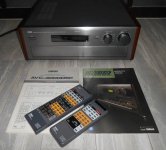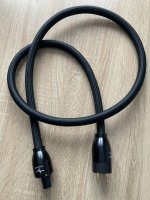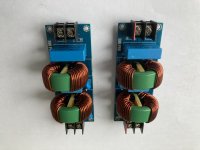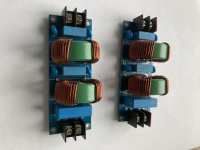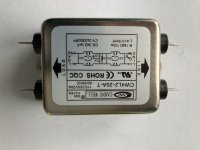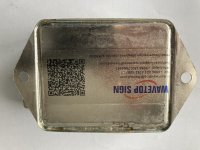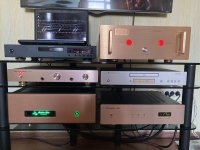Hey! Tell me, how hot are the 2sa970 and 2sc2240 transistors (does the finger tolerate heat or not)?
I also compared my Chinese preamplifier (I posted a photo) and the preamplifier of the NAD C352 integrated amplifier. I was disappointed with the result (my bright and little bass). Now this is coming to me:
I also compared my Chinese preamplifier (I posted a photo) and the preamplifier of the NAD C352 integrated amplifier. I was disappointed with the result (my bright and little bass). Now this is coming to me:
Attachments
Hi all. There were small questions to which I would like to hear an answer from a respected public. How much does the quiescent current in A60 and A60 + affect the quality of music? I mean the optimal limit is between 30-60mV. Will there be a difference if, say, radiators allow you to set 50mV, or can you stop at 30-35mV? And how do network filters affect amplifiers? There are different opinions on the forums and no one can really explain whether they are needed or not. For a source or a DAC, it's understandable, the manufacturers put it, but in our case?🤔
Attachments
Hello Berlusconi.
You once said that you use a stabilized amplifier power supply. Could you clarify if you stabilized all the power (including the power of the 5200/1943 transistors) or only the circuits for driving them on 970/2240? And yes, by the way, the replacement of the Chinese preamplifier with the Yamaha AVC 3000DSP met all expectations!
You once said that you use a stabilized amplifier power supply. Could you clarify if you stabilized all the power (including the power of the 5200/1943 transistors) or only the circuits for driving them on 970/2240? And yes, by the way, the replacement of the Chinese preamplifier with the Yamaha AVC 3000DSP met all expectations!
I have tested up to 60 mV and, in my humble opinion, 30 mV is fine. More quiescent current just increases temperature without notable difference in sound quality.Hi all. There were small questions to which I would like to hear an answer from a respected public. How much does the quiescent current in A60 and A60 + affect the quality of music? I mean the optimal limit is between 30-60mV. Will there be a difference if, say, radiators allow you to set 50mV, or can you stop at 30-35mV? And how do network filters affect amplifiers? There are different opinions on the forums and no one can really explain whether they are needed or not. For a source or a DAC, it's understandable, the manufacturers put it, but in our case?🤔
Hello @vmk2002. Good to hear from you again 😎...you stabilized all the power...
I usually use a conventional class A power supply and sometimes I use capacitance multiplier. In both cases power isn't stabilized but I don't intend to use regulated power supply. For time being I see no purpose of it.
Please, note that A60 has its own on-board power supply, which is /surprisingly) quite adequate but I wanted to try using additional power supply. It appears than in loud passages this affect the sound quality. Maybe this is a placebo effect, I don't know, really.
And yes, good preamp provides better sound quality. Your Yamaha did the trick. 👍
I think I understand now what makes this amplifier so remarkable and it is not low THD. I have found the answer elsewhere in an old thread, by DF96, the late highly respected member of this community. The quote is below and contains an extra useful information.
A60 has flat frequency response like a pancake from DC to 50-60 KHz. Exactly this characteristics makes its sound so pleasant. It doesn't roll-of in the audible region at all. It has perfect square wave response even at several Hertz. It should be noted that A60 doesn't have vanishingly small THD but it is dominated by the pleasant 2nd harmonics.
Also read carefully the 2nd paragraph of the quoted text. It is quite revealing for those who prefer "real" acoustic music. Sound quality indeed matters especially for classical music when you have to hear imperfections of the real instruments and real voices. And to feel movements and relative positions of performers on the stage.
DF96 said:
A60 has flat frequency response like a pancake from DC to 50-60 KHz. Exactly this characteristics makes its sound so pleasant. It doesn't roll-of in the audible region at all. It has perfect square wave response even at several Hertz. It should be noted that A60 doesn't have vanishingly small THD but it is dominated by the pleasant 2nd harmonics.
Also read carefully the 2nd paragraph of the quoted text. It is quite revealing for those who prefer "real" acoustic music. Sound quality indeed matters especially for classical music when you have to hear imperfections of the real instruments and real voices. And to feel movements and relative positions of performers on the stage.
DF96 said:
The biggest audible difference between power amps is frequency response. Second is output impedance (which causes frequency response wiggles). Blind tests have shown that if you equalise these, people cannot reliably distinguish one amp from another.
The sound of most recordings is not real, because it never was real. If you want reality you need to listen to acoustic music recorded with a coincident pair.
Close to finishing my A60 and super pleased with it. Just waiting on a 10A front switch and hooking up the speaker outs. Debating on putting a Zobel network there. Only issue I've had so far is the left channel board had a short to ground. Current limiter bulb tester did its job. Got that sorted out and dialed in to 28mv after warmed up. Have it hooked to some cheap speakers for now. Been running for several hours and sounds nice and
right. Grounding scheme seems to have worked excellent. No hum, dead silent.
I'd like to thank Berlusconi and everybody who has participated in this thread. It has been a good guide for me full of useful information. This is my first attempt at building a solid state power amp.

right. Grounding scheme seems to have worked excellent. No hum, dead silent.
I'd like to thank Berlusconi and everybody who has participated in this thread. It has been a good guide for me full of useful information. This is my first attempt at building a solid state power amp.
It’s a little unclear why a remote power supply is needed, since everything is organized on the board, even the delay in connecting acoustics without clicks. By the way, I removed the additional capacitors, it didn’t affect the sound, there are already 44,000 microfarads per channel. On loud music with an offset of 30-31mV, the temperature of the transistor 669 is 47.4 degrees. I left the temperature protection at 60 degrees. Later, I think I will raise it to 35mV.
Attachments
Good day everyone. I've been looking at this project for almost a year now. And I'm almost ready to buy boards, but I can't find mounting dimensions for A60 and A60+ anywhere. How much space do they take up on the radiator? Thank you.
Most Aliexpress listings have the board dimensions listed in the description.
A60 195*80MM
A60+ 273*88MM
A60 195*80MM
A60+ 273*88MM
Thank you. Are these the boards themselves? And together with the protruding transistors, how much does it turn out?
Most Aliexpress listings have the board dimensions listed in the description.
A60 195*80MM
A60+ 273*88MM
Hello! Produced a successful experiment with epoxy resin. Filled the transformer from China, putting it in a protective screen. Filled up in 2 doses. Now there is no buzz. This buzz, by the way, did not depend on the voltage in the network, since I have a filter for direct voltage. We are planning a long weekend, I think I have time to remake the second transformer.
Topa 41 Hello, write to me in a personal or open it in private on the forum where we talked on dartsile, I'll tell you and help you how to assemble it without problems.

Hi Paroxod4. Take a look at the PM on the Hobote (ixbt). There are questions for discussion on the A60+.
- Home
- Amplifiers
- Solid State
- A60(+) Amplifier. Build this?
